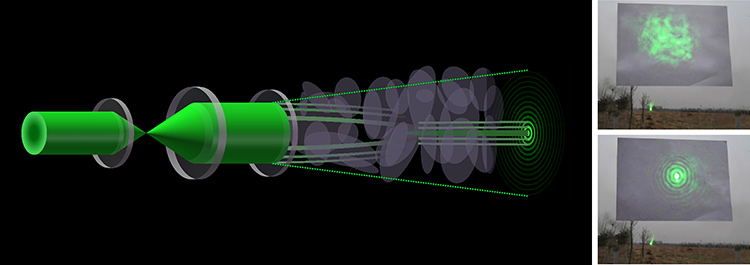 Left: Artist’s illustration of generation of a shape-preserving optical pin beam (OPB) from a single engineered phase mask and its propagation through atmospheric turbulence. Right: A Gaussian beam, propagating across 1 km in an open field, spreads and fluctuates dramatically (top), while the main lobe intensity of an OPB (bottom) remains localized under the same propagation conditions (see video). Laser source is visible in lower-left corner.
Left: Artist’s illustration of generation of a shape-preserving optical pin beam (OPB) from a single engineered phase mask and its propagation through atmospheric turbulence. Right: A Gaussian beam, propagating across 1 km in an open field, spreads and fluctuates dramatically (top), while the main lobe intensity of an OPB (bottom) remains localized under the same propagation conditions (see video). Laser source is visible in lower-left corner.
Humans have long dreamt of shape-preserving light beams that could propagate robustly without broadening and distortion—even through turbulent media. Ideally, one might achieve that goal using adaptive optics,1 diffraction-free beams such as Airy beams,2 or optical solitons.3 But complicated or unrealistic design requirements often make such techniques impractical for free-space applications.
Recently, we have demonstrated an “optical pin beam” (OPB) that exhibits unusual properties in long-distance propagation compared with conventional Gaussian beams.4 These beams can be efficiently generated with a single mask made by high-precision photo-etching on fused silica, and can robustly propagate amid turbulence over kilometer distances in an open field.
Intuitively, OPBs are created by assembling multiple pairs of Airy beam filaments in a circle. Each pair involves two Airy fragments bending toward the center, but from opposite directions. The resulting beam thus appears to undergo autofocusing during propagation, and to be anti-diffractive over long distances due to cancellation of the transverse wavevectors.
In one experiment, we sent light from a 2-W, 532-nm continuous-wave laser through an engineered phase mask with a conversion efficiency of about 90%. The resulting OPB, propagating over a long distance in exterior free space, experienced far less shape distortion and diffraction than a normal Gaussian beam in the same environment. The OPB had evolved into a Bessel-like intensity pattern after propagating 1 km; however, it is worth noting that, even under ideal conditions, Bessel beams realized using other currently available techniques can persist over only a few centimeters to meters.
Our work has demonstrated both how to generate anti-diffractive OPBs and their advantages over conventional Gaussian beams, Bessel beams and abruptly autofocusing Airy beams. In parallel with other recent efforts demonstrating the generation of various shaped light fields in space and time,5 we believe that our results may bring about a novel approach for designing laser beams with turbulence-resistant features for situations when passing through atmospheric turbulence is unavoidable.
Researchers
Ze Zhang, Xinli Liang and Xiuting Yang, Aerospace Information Research Inst., Chinese Academy of Sciences, Beijing, China
Mihalis Goutsoulas and Nikolaos K. Efremidis, University of Crete, Heraklion, Greece
Denghui Li and Jingjun Xu, Nankai University, Tianjin, China
Shupeng Yin, Beijing Institute of Special Electromechanical Technology, Beijing, China
Demetrios N. Christodoulides, CREOL, University of Central Florida, Orlando, Fla., USA
Zhigang Chen, San Francisco State University, San Francisco, Calif., USA
References
1. R.K. Tyson. Principles of Adaptive Optics (Academic, 1998).
2. N.K. Efremidis et al. Optica 6, 686 (2019).
3. Z. Chen et al. Rep. Prog. Phys. 75, 086401 (2012).
4. Z. Zhang et al. APL Photon. 4, 7 (2019).
5. H.E. Kondakci et al. Phys. Rev. Lett. 120, 163901 (2018).

